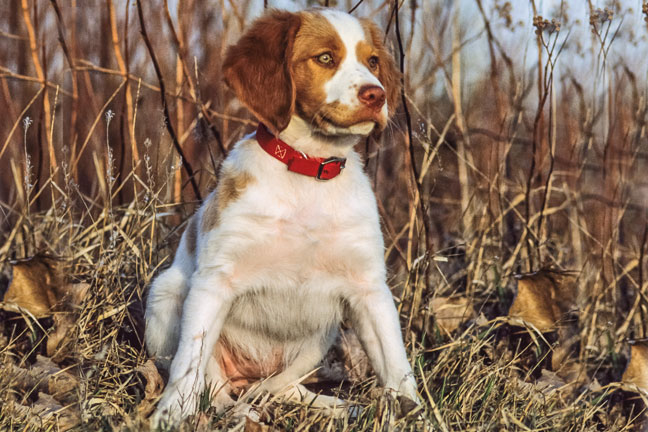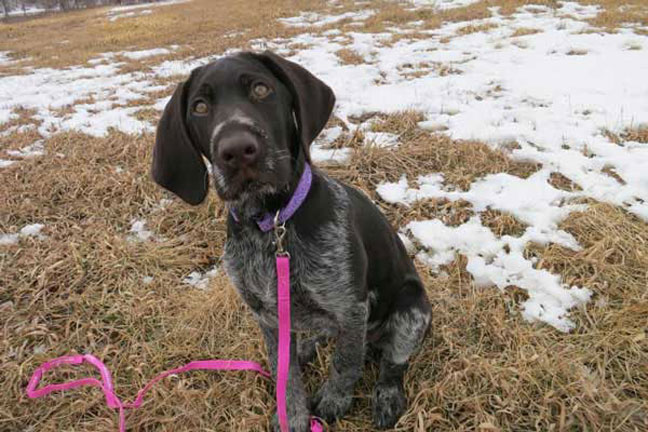
Problem:
I have a 2-year-old Brittany, my first bird dog. He has an excellent disposition and amazing natural instinct. I have completed some basic obedience training with him and some field work.
The first obedience command I taught him was "sit." This was followed by several other commands, including "whoa" (which I pronounce "wup"). Lately he has started sitting when issued the verbal or hand signal for "wup." He will stop in his tracks and then sit.
He is doing what I'm asking, but I do not want him to sit. My correction for this action is to walk over to him, pick him up and put him back in a standing position. Is this an issue I should be concerned with?
It bugs me more from an obedience standpoint because I am not commanding him to sit, but to simply "wup."
Any insight you have would be greatly appreciated.
Solution:
This is not an uncommon problem. Sometimes the unwanted behavior is actually taught by the trainer or breeder or people visiting the litter. Puppies jumping up is one of those unwanted behaviors when puppies seeking attention rush up to the wire.
The pup that is there first, jumping up, gets the petting. That is the pup selected first followed by hours or days teaching the dog not to jump on people. Lying down from a sit, rolling over from a down, suddenly putting a dummy down to scratch an itch or adding a short detour to the retrieve are all unwanted behaviors that can happen.
This problem is especially common in obedience classes where a dog is taught to sit immediately when the handler stops while walking the dog at heel. It then goes a step further when a young dog is taught to lie down on command. The dog is given a sit command and tends to lie down because it has learned to lie down from a sit position.

Dogs get confused, anticipating the next command and they do it before asked. Having done it one time means it is incorporated into the sequence so stop-stand-sit-down becomes the ingrained, chained together sequence. It can be difficult to change back to just stop and stand when that is the command, or just sit (and nothing more) when that is the command.
Springer spaniel and retriever people work hard to get their dogs to stop, sit and look toward the handler for the next instruction. Many would trade their first-born for a dog that sat on the "hup" or whistle command as easily and efficiently as your Brit.
Go back to the basics. For just wanting him to stop and stand, you will need to change the command from "wup" to something else. I would use one short blast on a whistle rather than another word because he would probably generalize to a new word like "whoa" and do his sit thing all over again.
Go back to walking at heel on leash in an enclosed area. Use the leash somewhat differently than just attached to the collar. The leash should be at least 6 feet long and attached by the snap end to the collar like normal. Hold the leash about two feet from the snap. Then pass the hand loop end under his belly, just in front of the hind legs and bring it up to hold it in the same hand (normally your left hand).
You now have control over both the front and hind ends with one hand about level with your waist. The dog is essentially being held like a suitcase with four feet on the ground, but you have both front and rear ends under complete control. Now walk him at heel around the yard, making figure eights and other left and right and 180 turns.
"Dogs get confused, anticipating the next command and they do it before asked"
When he is fully concentrating on walking at heel, toot your whistle and instantly stop walking. Don't use any words, only the whistle. If he tries to sit, give a short toot on the whistle and keep his rear end up by holding up the hind legs with the leash. Then while he is stopped and standing, step out in front of him, then walk behind him and back again, always keeping him on all fours.
Praise him or give him a treat, and then walk on telling him to heel. After some walking, repeat the whistle, stop and do the walk in front, behind and all the way around him, always keeping him facing forward with the front part of the leash and standing erect with the rear two-thirds of the leash. Then repeat the whole process so you are doing three or four repetitions in about a 15-minute period. You can repeat this lesson two or three times a day.
After a few days of this sequence, you can alter it again by blowing the whistle, dropping the leash and walking on a few steps ahead, turn and come back, walk around him, then pick up the leash and walk at heel again. When you can walk ahead and out of sight for a few seconds before returning to him, try it without the leash but still in the yard.
When he is fail-safe without the leash in the yard, go outside the yard first on leash and later off leash and finally out into the field, on leash for a time or two, then off leash and then when he is a short distance away and walking or trotting and so on. Use small increases in difficulty and if ever it doesn't work, back up a few steps and continue a bit more slowly.
If you mistakenly say "wup" and he stops and sits, ignore it or even praise him for it. There may be times when you want him to sit and look to you for more direction.
The stop and stand to the whistle is a new command for a new sequence so never blow the whistle and say "wup" or he will quickly learn to sit on the whistle, which you don't want.
One thing to remember is always go to your dog to release him from the stop/stand until you have him totally foolproof and can stop him in the field at any distance, even with distractions like rabbits running or birds flying.
For solutions to your dog's behavior problem or behavior-related training problem, contact Ed Bailey at: edbailey@uoguelph.ca






